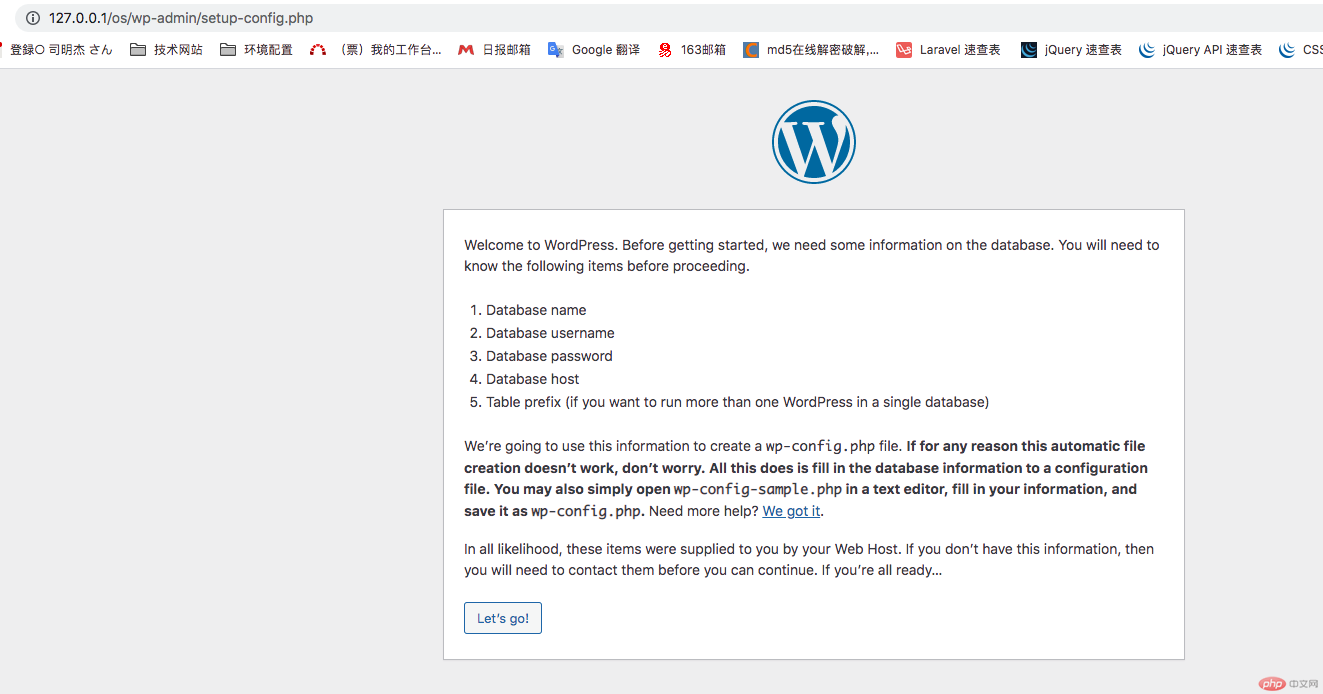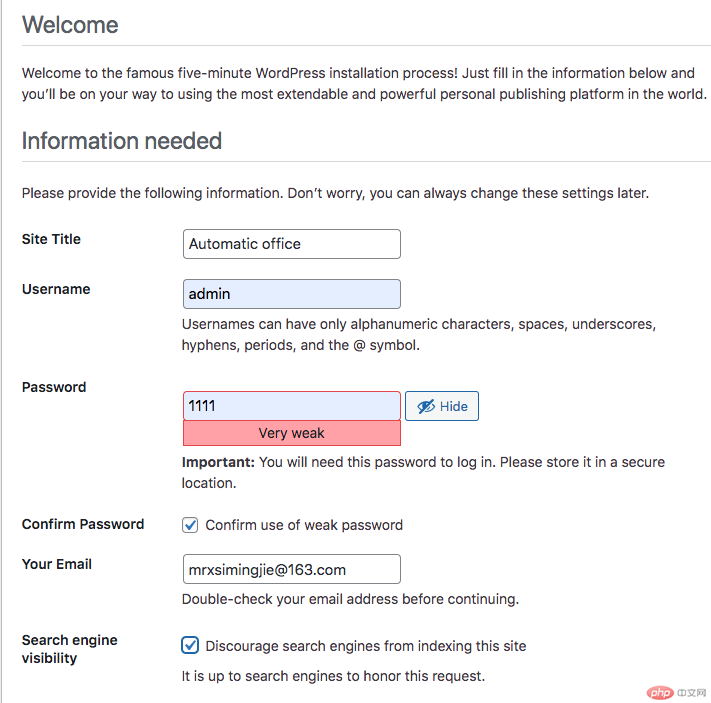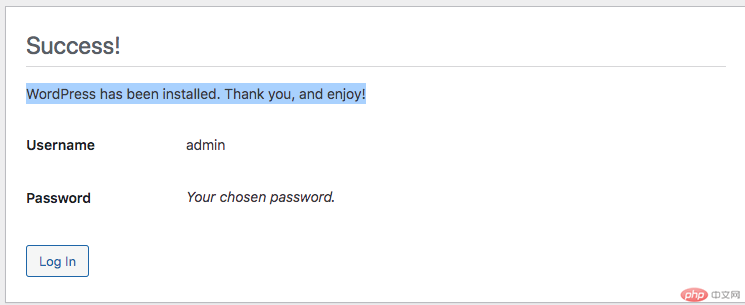WordPress local environment configuration (image and text steps)
I have always been curious about the wordpress website. I have always heard that it is very convenient to use and just configure it locally, but I have never used it. I checked the official website today and compiled the local configuration information below. Hope this helps everyone.
1. Search "wordpress download" online and download the wordpress package.
Direct download URL: https://wordpress.org/download/

2. Download the wordpress package, unzip and put Go to the service project path(/Users/gaopeng/eclipse-workspace/wordpress/)
Local server configuration:
Alias /os/ "/Users/gaopeng/eclipse-workspace/wordpress/" <Directory "/Users/gaopeng/eclipse-workspace/wordpress/"> AllowOverride All Order allow,deny Allow from All </Directory>
3. WordPress creates a Mysql database (name is English, language utf8_general_ci)
wp-config-sample.phpFile database configuration
/** The name of the database for WordPress */ define( 'DB_NAME', 'database_name_here' ); /** MySQL database username */ define( 'DB_USER', 'username_here' ); /** MySQL database password */ define( 'DB_PASSWORD', 'password_here' ); /** MySQL hostname */ define( 'DB_HOST', 'localhost' ); /** Database charset to use in creating database tables. */ define( 'DB_CHARSET', 'utf8' ); /** The database collate type. Don't change this if in doubt. */ define( 'DB_COLLATE', '' );
According to the information of your own computer Configuration, I configured it as follows:
The username and password are the following information:
/** MySQL database username */ define('DB_USER', 'root'); /** MySQL database password */ define('DB_PASSWORD', '1'); /** MySQL hostname */ define('DB_HOST', '127.0.0.1'); /** Database Charset to use in creating database tables. */ define('DB_CHARSET', 'utf8'); /** The database collate type. Don't change this if in doubt. */ define( 'DB_COLLATE', 'utf8_general_ci' );
4. Install wordpress
Step 1: Enter http://127.0.0.1/os/
 in the browser address bar. Step 2: "Create configuration file" in the text editor Open wp-config-sample.php, fill in the database information, and save it as wp-config.php. Then click the "let's go!" button;
in the browser address bar. Step 2: "Create configuration file" in the text editor Open wp-config-sample.php, fill in the database information, and save it as wp-config.php. Then click the "let's go!" button;
Step 3: Fill in the information in the entered page (fill in the database name just created wdpress for the database name, fill in root for the user name, and fill in the password 1,Database Host:127.0.0.1,Table Prefix:wp), then click the "Submit" button.
Step 4: Click the "Install" button. (Run the install)


5. Solve the problem that WordPress requires FTP to install themes or plug-ins
In the wp-content directory, create a new tmp folder and set the folder permissions to 777
Modification: Add the following code in wp-config.php:
define('WP_TEMP_DIR', ABSPATH.'wp-content/tmp'); /* WordPress的临时目录。*/
define("FS_METHOD", "direct");
define("FS_CHMOD_DIR", 0777);
define("FS_CHMOD_FILE", 0777);Note: To Define ABSPATH, that is, add this code after it:
if ( !defined('ABSPATH') ) define('ABSPATH', dirname(__FILE__) . '/');
6. Language switching (language pack download)
In wp-confing. phpAdd define('WPLANG', 'zh_CN');
In the wp-content directory, create a new languages folder and set the folder permissions to 777
Enter the site control panel (dashboard) and upgrade after seeing the update prompt. WordPress will automatically download the Chinese language pack from the official website and install it.
7. Install the plug-in
Select the plug-in you want to use and install it.
1.Wordpress File Upload (Plug-in for uploading files from the page.)
2.Multisite Language Switcher (Multisite language switcher: a plug-in that should be used when creating sub-sites in different languages)
When updating plug-ins, themes, etc. in the apache environment server fails (error: Because we cannot copy some files, the upgrade was not installed. This is usually because of inconsistent file permissions.), just open the permissions of the corresponding file That's it (for 777).
The above is the most basic configuration. The following configuration will not be explained in detail. You can configure it according to your own business needs. If you don't understand something, you can leave a message. Thank you for your support. Hope this helps everyone. [Related recommendations: WordPress Tutorial]
The above is the detailed content of WordPress local environment configuration (image and text steps). For more information, please follow other related articles on the PHP Chinese website!

Hot AI Tools

Undresser.AI Undress
AI-powered app for creating realistic nude photos

AI Clothes Remover
Online AI tool for removing clothes from photos.

Undress AI Tool
Undress images for free

Clothoff.io
AI clothes remover

AI Hentai Generator
Generate AI Hentai for free.

Hot Article

Hot Tools

Notepad++7.3.1
Easy-to-use and free code editor

SublimeText3 Chinese version
Chinese version, very easy to use

Zend Studio 13.0.1
Powerful PHP integrated development environment

Dreamweaver CS6
Visual web development tools

SublimeText3 Mac version
God-level code editing software (SublimeText3)

Hot Topics
 1378
1378
 52
52
 PHP vs. Flutter: The best choice for mobile development
May 06, 2024 pm 10:45 PM
PHP vs. Flutter: The best choice for mobile development
May 06, 2024 pm 10:45 PM
PHP and Flutter are popular technologies for mobile development. Flutter excels in cross-platform capabilities, performance and user interface, and is suitable for applications that require high performance, cross-platform and customized UI. PHP is suitable for server-side applications with lower performance and not cross-platform.
 How to change page width in wordpress
Apr 16, 2024 am 01:03 AM
How to change page width in wordpress
Apr 16, 2024 am 01:03 AM
You can easily modify your WordPress page width by editing your style.css file: Edit your style.css file and add .site-content { max-width: [your preferred width]; }. Edit [your preferred width] to set the page width. Save changes and clear cache (optional).
 How to create a product page in wordpress
Apr 16, 2024 am 12:39 AM
How to create a product page in wordpress
Apr 16, 2024 am 12:39 AM
Create a product page in WordPress: 1. Create the product (name, description, pictures); 2. Customize the page template (add title, description, pictures, buttons); 3. Enter product information (stock, size, weight); 4 . Create variations (different colors, sizes); 5. Set visibility (public or hidden); 6. Enable/disable comments; 7. Preview and publish the page.
 In which folder are wordpress articles located?
Apr 16, 2024 am 10:29 AM
In which folder are wordpress articles located?
Apr 16, 2024 am 10:29 AM
WordPress posts are stored in the /wp-content/uploads folder. This folder uses subfolders to categorize different types of uploads, including articles organized by year, month, and article ID. Article files are stored in plain text format (.txt), and the filename usually includes its ID and title.
 Where is the wordpress template file?
Apr 16, 2024 am 11:00 AM
Where is the wordpress template file?
Apr 16, 2024 am 11:00 AM
WordPress template files are located in the /wp-content/themes/[theme name]/ directory. They are used to determine the appearance and functionality of the website, including header (header.php), footer (footer.php), main template (index.php), single article (single.php), page (page.php), Archive (archive.php), category (category.php), tag (tag.php), search (search.php) and 404 error page (404.php). By editing and modifying these files, you can customize the appearance of your WordPress website
 How to search for authors in WordPress
Apr 16, 2024 am 01:18 AM
How to search for authors in WordPress
Apr 16, 2024 am 01:18 AM
Search for authors in WordPress: 1. Once logged in to your admin panel, navigate to Posts or Pages, enter the author name using the search bar, and select Author in Filters. 2. Other tips: Use wildcards to broaden your search, use operators to combine criteria, or enter author IDs to search for articles.
 What language is used to develop WordPress?
Apr 16, 2024 am 12:03 AM
What language is used to develop WordPress?
Apr 16, 2024 am 12:03 AM
WordPress is developed using PHP language as its core programming language for handling database interactions, form processing, dynamic content generation, and user requests. PHP was chosen for reasons including cross-platform compatibility, ease of learning, active community, and rich library and frameworks. Apart from PHP, WordPress also uses languages like HTML, CSS, JavaScript, SQL, etc. to enhance its functionality.
 Which version of wordpress is stable?
Apr 16, 2024 am 10:54 AM
Which version of wordpress is stable?
Apr 16, 2024 am 10:54 AM
The most stable WordPress version is the latest version because it contains the latest security patches, performance enhancements, and introduces new features and improvements. In order to update to the latest version, log into your WordPress dashboard, go to the Updates page and click Update Now.




